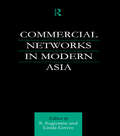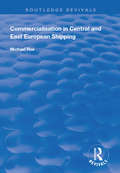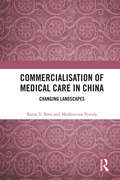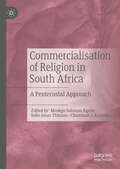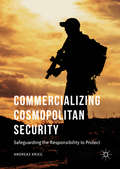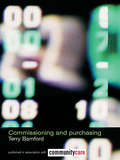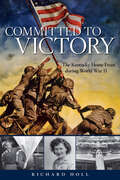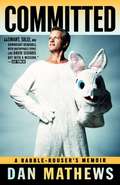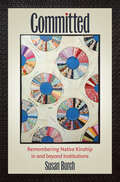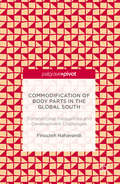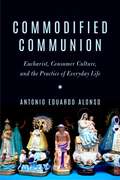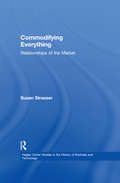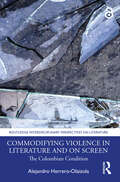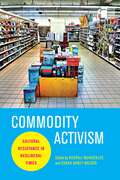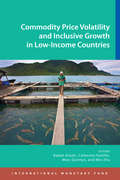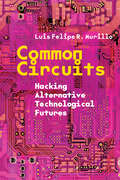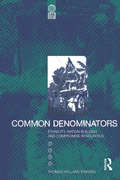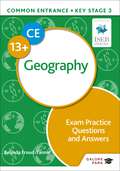- Table View
- List View
Commercial Networks in Modern Asia
by Linda Grove Shinya SugiyamaThis volume brings together an international team of scholars who examine the development of commercial networks in Asia from the 18th century to the 20th century on a stage that stretches from Yokohama and Pusan to Istanbul. The studies, based on extensive archival research, focus on the trading firms and merchant groups that were the chief actors in the creation of the commercial networks that crisscrossed Asia, linking the various Asian economies to each other and to Europe and the Americas. While some of this work has been available in Japanese, Chinese and Dutch, this is the first time that such a broad range of essays has been made available to an English-speaking audience.The thirteen essays can be roughly divided into two groups. The first group includes essays that look at the development of large scale networks and plot the competition between competing indigenous and foreign merchant groups in the trade in such products as sugar and cotton yarn in China, cotton goods in Japan, silk in Iran, Japanese manufactures in Dutch Indonesia and rice and cotton in India. The second group of essays focuses on the activities of specific firms as a way to explore the development of trading networks. This group includes essays that look at the activities of Chinese and Japanese merchants in Korea, at the growth of a commercial empire built on the sale of patent drugs in Southeast Asia and at the activities of European trading firms in Asia.The book should appeal to a wide-range audience. Most directly concerned are economic historians
Commercialisation in Central and East European Shipping (Routledge Revivals)
by Michael RoePublished in 1998, this text provides an insight into the process of change in the east European shipping industry following the political, social and economic developments of the late 1980s and 1990s in the region. Stemming from extended periods of consultation with the Polish shipping and maritime industry, the text discusses the impact of change on all sectors including ship opearators, port managers, charterers, freight forwarders, and suppliers and land transport providers in companies that emerged from the previously monopolized state sector, which is now being forced to come to terms with the new economic liberalization of the industry. The research forming the basis of this text was funded by the European Union through the PHARE (ACE) programme from 1996 to 1997 and was developed from a protracted period of collaboration between the Institute of Marine Studies at the University of Plymouth with the industry that commenced in 1989.
Commercialisation of Medical Care in China: Changing Landscapes
by Rama V. Baru Madhurima NundyThis book explores the changing landscapes of the commercialisation of medical care in China. It is the first work of its kind, and discusses how the rise of market socialism, coupled with decollectivisation of agriculture and autonomisation of hospitals in rural and urban China, have fragmented the health service system. The book examines public hospital reforms; the rise of the medical–industrial complex; the emerging public–private partnerships in the health sector; the challenges of financing; and the growing inequalities in access to health services, to present a comprehensive view of the Chinese health care system over the last four decades. This topical book will be useful to scholars and researchers of Chinese studies, Chinese economy, public health, health management, social health and medicine, medical sociology, sociology, political economy, public policy and public administration as well as policymakers and practitioners.
Commercialisation of Religion in South Africa: A Pentecostal Approach
by Chammah J. Kaunda Mookgo Solomon Kgatle Jonas Sello ThinaneAspects of the 2017 Final Report of the South African Commission on the Promotion and Protection of the Rights of Cultural, Religious and Linguistic Communities (CRL) have drawn strong criticism, particularly from South African scholars, politicians and the public. The criticism is largely regarding the constitutionality of its recommendation, which calls for regulation of the Religion to combat its abuse and commercialization. Scholars have criticized the CRL Rights Commission for hastening its investigation and releasing the final report without having a substantive understanding of what is meant by the commercialization of religion, and consequently the unconstitutional implications of the recommendation, to regulate religion. A close reading of this critique has pointed to the urgent need to assemble a cumulative body of research that examines and advances understanding of what is meant by the commercialization of religion. Accordingly, this book gathers scholarly contributions which offer valuable insights into the basics of what is meant by the commercialization of religion. Contributors examine this phenomenon from the historical roots to the manifestation in the contemporary world, particularly in South Africa.
Commercializing Cosmopolitan Security: Safeguarding the Responsibility to Protect
by Andreas KriegThis book analyses two key topics within international politics: the responsibility to protect (R2P) and the commercialization and privatization of security. In a world of ungoverned spaces, state failure and erupting humanitarian crises, the international community is increasingly called upon to exercise its responsibility to protect communities under threat. Here, Krieg explains the civil-military dynamics behind the state's failure to effectively intervene in humanitarian crises overseas using its serviceman. The central question that follows is: would the private military contractor be a better alternative agent of the state in humanitarian intervention? This book demonstrates that given his professional identity and role towards client state and public, the contractor can be employed effectively in humanitarian intervention to generate more ethical outcomes. This volume is essential reading for researchers and post-graduate students of R2P, International Security Studies and privatization, as well as Peace and Conflict studies and International Relations more broadly.
Commingled and Disarticulated Human Remains: Working Toward Improved Theory, Method, and Data
by Debra L. Martin Anna J. Osterholtz Kathryn M. BaustianCommingled and Disarticulated Human Remains:Working Toward Improved Theory, Method, and Data brings together research that provides innovative methodologies for the analysis of commingled human remains. It has temporal and spatial breadth, with case studies coming from pre-state to historic periods, as well as from both the New and Old World. Highlights of this volume include: standardizes methods and presents best practices in the field using a case study approach demonstrates how data gathered from commingled human remains can be incorporated into the overall interpretation of a site explores best way to formulate population size, using commingled remains Field archaeologists, bioarchaeologists, academic anthropologists, forensic anthropologists, zoo archaeologists, and students of anthropology and archaeology will find this to be an invaluable resource.
Commissioning and Purchasing (The Social Work Skills Series #Vol. 2)
by Terry BamfordThis essential guide to commissioning and purchasing in social care provides case studies, guidelines, and checklists to help readers to assess need, develop care plans and select suppliers of care. It clearly explains: the reasons for the shift to commissioning and purchasing away from direct provision the distinction between commissioning and purchasing how to ensure that the commissioning and purchasing process fully reflects the views of users and carers contracts and tenders costs and prices in relation to providing quality care how safeguards can be built into the commissioning and purchasing process. This is an invaluable resource that focuses on the practical skills required to deliver effective care. It has been written for social care students, frontline staff and their managers to help them through the process.
Committed to Victory: The Kentucky Home Front during World War II (Topics In Kentucky History Ser.)
by Richard Holl“Deeply researched and clearly written . . . a wide-ranging and detailed account of Kentucky’s society, economy, and politics during World War II.” —John W. Jeffries, author of Wartime AmericaWhen World War II broke out in Europe in September 1939, Kentucky was still plagued by the Great Depression. Even though the inevitably of war had become increasingly apparent earlier that year, the citizens of the Commonwealth continued to view foreign affairs as a lesser concern compared to issues such as the lingering economic depression, the approaching planting season, and the upcoming gubernatorial race. It was only the Japanese attack on Pearl Harbor that destroyed any lingering illusions of peace.In Committed to Victory: The Kentucky Home Front During World War II, author Richard Holl offers the first comprehensive examination of the Commonwealth’s civilian sector during this pivotal era in the state’s history. National mobilization efforts rapidly created centers of war production and activity in Louisville, Paducah, and Richmond, producing new economic prosperity in the struggling region. The war effort also spurred significant societal changes, including the emergence of female and minority workforces in the state. In the Bluegrass, this trend found its face in Pulaski County native Rose Will Monroe, who was discovered as she assembled B-24 and B-29 bombers and was cast as Rosie the Riveter in films supporting the war effort.Revealing the struggles and triumphs of civilians during World War II, Holl illuminates the personal costs of the war, the black market for rationed foods and products, and even the inspiration that coach Adolph Rupp and the University of Kentucky basketball team offered to a struggling state.
Committed: A Rabble-rouser's Memoir
by Dan MathewsCommitted is a bold, offbeat, globe-trotting memoir that shows how the most ridiculed punching bag in high school became an internationally renowned crusader for the most downtrodden individuals of all -- animals. This irresistibly entertaining book recounts the random incidents and soul-searching that inspired a reluctant party boy to devote his life to a cause, without ever abandoning his sense of mischief and fun. "Everyone has a tense moment in their career that makes them wonder, how the hell did I get into this mess?" writes Mathews. "For me, it was when I was dressed as a carrot to promote vegetarianism outside an elementary school in Des Moines, and a pack of obese pig farmers showed up and peeled off slices of bologna for kids to throw at me." As the irreverent force behind the colorful crusades carried out by People for the Ethical Treatment of Animals (PETA), one of the most effective and enduring pressure groups in the world, Mathews has strutted naked before a fur convention in Tokyo, halted GM's use of animals in crash tests by storming the carmaker's float in the Rose Parade dressed as a rabbit, and crashed a fashion show in Milan dressed as a priest. With self-deprecating wit and candor, Mathews reveals all the edgy details of his unorthodox coming-of-age and equally outrageous career. With backdrops such as the rock scene in Hollywood and London, the inner sanctums of New York high fashion, jails in Hong Kong and Boston, and a psychiatric ward in Paris, Committed spotlights the adventures life can offer when you don't abandon your youthful ideals and imagination.
Committed: Remembering Native Kinship in and beyond Institutions (Critical Indigeneities)
by Susan BurchBetween 1902 and 1934, the United States confined hundreds of adults and children from dozens of Native nations at the Canton Asylum for Insane Indians, a federal psychiatric hospital in South Dakota. But detention at the Indian Asylum, as families experienced it, was not the beginning or end of the story. For them, Canton Asylum was one of many places of imposed removal and confinement, including reservations, boarding schools, orphanages, and prison-hospitals. Despite the long reach of institutionalization for those forcibly held at the Asylum, the tenacity of relationships extended within and beyond institutional walls. In this accessible and innovative work, Susan Burch tells the story of the Indigenous people—families, communities, and nations, across generations to the present day—who have experienced the impact of this history. Drawing on oral history interviews, correspondence, material objects, and archival sources, Burch reframes the histories of institutionalized people and the places that held them. Committed expands the boundaries of Native American history, disability studies, and U.S. social and cultural history generally.
Commodification of Body Parts in the Global South: Transnational Inequalities and Development Challenges
by Firouzeh NahavandiThisbook proposes the introduction of a development-related perspective toscholarly critique of the human body's commodification. Nahavandi contends that the commodification of humanbody parts reflects a modern form of such well-known historical phenomena asslavery and colonization, and can be considered a new and additional form ofappropriation and extraction of resources from the Global South. Whatare the commonalities between hairtrade, surrogacy, kidney sale and attraction of brains? The author argues that these allcharacterize a world where increasingly everything can be traded or is consideredto be tradeable. A world where, similar to any other goods, body parts haveentered the global market either legally or illegally. Through a series ofmultidisciplinary comparative studies, the book explores how formscommodification of the human body are fuelled by issues of poverty in theGlobal South, and inequality in transnational relations.
Commodified Bodies: Organ Transplantation and the Organ Trade (Routledge Studies in Science, Technology and Society #24)
by Oliver DeckerCommodified Bodies examines the social practice of organ transplantation and trafficking and scrutinises the increasingly neoliberal tendencies in the medical system. It analyses phenomena such as the denomination of human body parts as "raw materials" and "commodities," or the arguments used by the proponents for a free market solution. Moreover, it argues that modern medicine is still linked with its religious roots. The commodification of body parts is seen not as an imperialistic act of the market, but as the end of a historical process as the notion of "fetishism" links the market with the body. Marx’s concept of commodity fetishism and Sigmund Freud’s theory of the perverted use of objects are modified and adapted to the reconstruction of the joint beginnings of market and medicine.
Commodified Communion: Eucharist, Consumer Culture, and the Practice of Everyday Life
by Antonio Eduardo AlonsoWINNER, 2021 HTI BOOK PRIZEResist! This exhortation animates a remarkable range of theological reflection on consumer culture in the United States. And for many theologians, the source and summit of Christian cultural resistance is the Eucharist. In Commodified Communion, Antonio Eduardo Alonso calls into question this dominant mode of theological reflection on contemporary consumerism. Reducing the work of theology to resistance and centering Christian hope in a Eucharist that might better support it, he argues, undermines our ability to talk about the activity of God within a consumer culture. By reframing the question in terms of God’s activity in and in spite of consumer culture, this book offers a lived theological account of consumer culture that recognizes not only its deceptions but also traces of truth in its broken promises and fallen hopes.
Commodifying Everything: Relationships of the Market (Hagley Center Studies in the History of Business and Technology #Vol. 4)
by Susan StrasserCommodification refers most explicitly to the activities of turning things into commodities and of commercializing that which is not commercial in essence. The mass marketing of pets, the rise of the coffin industry, the conversion of preacher into salesmen, and the globalization of Taleggio cheese are some of the exciting but surprising topics in this volume that show how friendship, death, spirituality, and artisanship all have a price after being commodified. This unique collection of essays is a fascinating take on creating consumer products and consumer identities when what's for sale goes well beyond the thing itself. It will be a course-in-a-box for instructors who want to teach their students about commodification.
Commodifying Violence in Literature and on Screen: The Colombian Condition (Routledge Interdisciplinary Perspectives on Literature)
by Alejandro Herrero-OlaizolaThis book traverses the cultural landscape of Colombia through in-depth analyses of displacement, local and global cultures, human rights abuses, and literary and media production. Through an exploration of the cultural processes that perpetuate the "darker side" of Latin America for global consumption, it investigates the "condition" that has led writers, filmmakers, and artists to embrace (purposefully or not) the incessant violence in Colombian society as the object of their own creative endeavors. In this examination of mass-marketed cultural products such as narco-stories, captivity memoirs, gritty travel narratives, and films, Herrero-Olaizola seeks to offer a hemispheric approach to the role played by Colombia in cultural production across the continent where the illicit drug trade has made significant inroads. To this end, he identifies the "Colombian condition" within the parameters of the global economy while concentrating on the commodification of Latin America’s violence for cultural consumption.
Commodities and Culture in the Colonial World (Intersections: Colonial and Postcolonial Histories)
by Rajeswari Sunder Rajan Josephine McDonagh Supriya Chaudhuri Brian H. MurrayCommodity, culture and colonialism are intimately related and mutually constitutive. The desire for commodities drove colonial expansion at the same time that colonial expansion fuelled technological invention, created new markets for goods, displaced populations and transformed local and indigenous cultures in dramatic and often violent ways. This book analyses the transformation of local cultures in the context of global interaction in the period 1851–1914. By focusing on episodes in the social and cultural lives of commodities, it explores some of the ways in which commodities shaped the colonial cultures of global modernity. Chapters by experts in the field examine the production, circulation, display and representation of commodities in various regional and national contexts, and draw on a range of theoretical and disciplinary approaches. An integrated, coherent and urgent response to a number of key debates in postcolonial and Victorian studies, world literature and imperial history, this book will be of interest to researchers with interests in migration, commodity culture, colonial history and transnational networks of print and ideas.
Commodities of Care: The Business of HIV Testing in China
by Elsa L. FanHow global health practices can end up reorganizing practices of care for the people and communities they seek to serve Commodities of Care examines the unanticipated effects of global health interventions, ideas, and practices as they unfold in communities of men who have sex with men (MSM) in China. Targeted for the scaling-up of HIV testing, Elsa L. Fan examines how the impact of this initiative has transformed these men from subjects of care into commodities of care: through the use of performance-based financing tied to HIV testing, MSM have become a source of economic and political capital. In ethnographic detail, Fan shows how this particular program, ushered in by global health donors, became the prevailing strategy to control the epidemic in China in the late 2000s. Fan examines the implementation of MSM testing and its effects among these men, arguing that the intervention produced new markets of men, driven by the push to meet testing metrics. Fan shows how men who have sex with men in China came to see themselves as part of a global &“MSM&” category, adopting new selfhoods and socialities inextricably tied to HIV and to testing. Wider trends in global health programming have shaped national public health responses in China and, this book reveals, have radically altered the ways health, disease, and care are addressed.
Commodity Activism: Cultural Resistance in Neoliberal Times (Critical Cultural Communication #21)
by Sarah Banet-Weiser Roopali MukherjeeBuying (RED) products—from Gap T-shirts to Apple—to fight AIDS. Drinking a “Caring Cup” of coffee at the Coffee Bean & Tea Leaf to support fair trade. Driving a Toyota Prius to fight global warming. All these commonplace activities point to a central feature of contemporary culture: the most common way we participate in social activism is by buying something. Roopali Mukherjee and Sarah Banet-Weiser have gathered an exemplary group of scholars to explore this new landscape through a series of case studies of “commodity activism.” Drawing from television, film, consumer activist campaigns, and cultures of celebrity and corporate patronage, the essays take up examples such as the Dove “Real Beauty” campaign, sex positive retail activism, ABC’s Extreme Home Makeover, and Angelina Jolie as multinational celebrity missionary.Exploring the complexities embedded in contemporary political activism, Commodity Activism reveals the workings of power and resistance as well as citizenship and subjectivity in the neoliberal era. Refusing to simply position politics in opposition to consumerism, this collection teases out the relationships between material cultures and political subjectivities, arguing that activism may itself be transforming into a branded commodity.
Commodity Price Volatility and Inclusive Growth in Low-Income Countries
by Marc Quintyn Catherine Pattillo Rabah Arezki Min ZhuIn the years following the global financial crisis, many low-income countries experienced rapid recovery and strong economic growth. However, many are now facing enormous difficulties because of rapidly rising food and fuel prices, with the threat of millions of people being pushed into poverty around the globe. The risk of continued food price volatility is a systemic challenge, and a failure in one country has been shown to have a profound impact on entire regions. This volume addresses the challenges of commodity price volatility for low-income countries and explores some macroeconomic policy options for responding to commodity price shocks. The book then looks at inclusive growth policies to address inequality in commodity-exporting countries, particularly natural resource rich countries. Perspectives from the Middle East and North Africa, sub-Saharan Africa, emerging Asia, and Mexico are presented and, finally, the role of the international donor community is examined. This volume is a must read for policymakers everywhere, from those in advanced, donor countries to those in countries with the poorest and most vulnerable populations.
Common Circuits: Hacking Alternative Technological Futures
by Luis Felipe MurilloHow hackers facilitate community technology projects that counter the monoculture of "big tech" and point us to brighter, innovative horizons. A digital world in relentless movement—from artificial intelligence to ubiquitous computing—has been captured and reinvented as a monoculture by Silicon Valley "big tech" and venture capital firms. Yet very little is discussed in the public sphere about existing alternatives. Based on long-term field research across San Francisco, Tokyo, and Shenzhen, Common Circuits explores a transnational network of hacker spaces that stand as potent, but often invisible, alternatives to the dominant technology industry. In what ways have hackers challenged corporate projects of digital development? How do hacker collectives prefigure more just technological futures through community projects? Luis Felipe R. Murillo responds to these urgent questions with an analysis of the hard challenges of collaborative, autonomous community-making through technical objects conceived by hackers as convivial, shared technologies. Through rich explorations of hacker space histories and biographical sketches of hackers who participate in them, Murillo describes the social and technical conditions that allowed for the creation of community projects such as anonymity and privacy networks to counter mass surveillance; community-made monitoring devices to measure radioactive contamination; and small-scale open hardware fabrication for the purposes of technological autonomy. Murillo shows how hacker collectives point us toward brighter technological futures—a renewal of the "digital commons"—where computing projects are constantly being repurposed for the common good.
Common Culture: Reading and Writing about American Popular Culture (7th Edition)
by Madeleine Sorapure Michael PetraccaTextbook on American popular culture, social life, and customs.
Common Denominators: Ethnicity, Nation-Building and Compromise in Mauritius (Global Issues Ser.)
by Thomas Hylland EriksenThis book seeks to enhance comparative understandings of ethnicity, to refine theories of nationalism, and to contribute to ongoing debates on multiculturalism, identity politics and creolization. Mauritius, an Indian Ocean island-state with a population of about one million, provides a fascinating focus for this comprehensive study of social identity and political culture. Fifteen languages are officially spoken on the island, and four world religions are represented, as well as a high number of ethnic groups. The author argues that the social importance of ethnicity depends not only on political and economic circumstances, but also on kinship organization, and shows how ethnicity is expressed through the idioms of language and religion. However, it is also shown how ethnic identity may be superseded by other forms of belongingness and politics in the contemporary age. Nationhood, gender, class and individualism are all examined for the role they play in social organization and the formation of collective identity. Multiethnic and peaceful, the pace of social change in Mauritius has been rapid throughout the 1980s and 1990s. The ways in which Mauritians negotiate the relationship between ethnic, national and other identities in forging a surprisingly stable and democratic society, and the peculiar tensions which arise in the interface between the ethnic and the non-ethnic, ought to be familiar to anyone concerned with the future of multiethnic societies.
Common Differences: Conflicts in Black and White Feminist Perspectives
by Jill Lewis Gloria JosephCOMMON DIFFERENCES is an unprecedented and unparalleled examination and analysis of an alarming schism in the women's movement: the differences between Black and White women's perspectives, attitudes and concerns on key issues. Written from a political perspective that considers sexism, racism, and classism as the major components affecting the attitudes held by Black and White women today, this book presents an overview of women's status through history and discusses the vital issues where common differences occur: sexuality, men and marriage, mothers and daughters, media images, and the direction of the movement itself. The nature of the schism between Black and White women is brought into sharp focus by a brilliant selection of interviews with a spectrum of women -- the rich, the poor and the so-called middle class, the educated and the illiterate, the domestic and the prostitute, professional women and welfare mothers, lesbians and debutantes, radicals and conservatives, and the elderly and the youthful, all make important contributions in explaining their different consciousnesses and needs.
Common Enemies: Georgetown Basketball, Miami Football, and the Racial Transformation of College Sports
by Thomas F. SchallerDuring the 1980s Black athletes and other athletes of color broadened the popularity and profitability of major-college televised sports by infusing games with a &“Black style&” of play. At a moment ripe for a revolution in men&’s college basketball and football, clashes between &“good guy&” white protagonists and bombastic &“bad boy&” Black antagonists attracted new fans and spectators. And no two teams in the 1980s welcomed the enemy&’s role more than Georgetown Hoya basketball and Miami Hurricane football. Georgetown and Miami taunted opponents. They celebrated scores and victories with in-your-face swagger. Coaches at both programs changed the tenor of postgame media appearances and the language journalists and broadcasters used to describe athletes. Athletes of color at both schools made sports apparel fashionable for younger fans, particularly young African American men. The Hoyas and the &’Canes were a sensation because they made the bad-boy image look good. Popular culture took notice. In the United States sports and race have always been tightly, if sometimes uncomfortably, entwined. Black athletes who dare to challenge the sporting status quo are often initially vilified but later accepted. The 1980s generation of barrier-busting college athletes took this process a step further. True to form, Georgetown&’s and Miami&’s aggressive style of play angered many fans and commentators. But in time their style was not only accepted but imitated by others, both Black and white. Love them or hate them, there was simply no way you could deny the Hoyas and the Hurricanes.
Common Entrance 13+ Geography Exam Practice Questions and Answers
by Belinda Froud-YannicExam board: ISEB Level: 13+ CE and KS3 Subject: Geography First exam: November 2022Help pupils feel fully prepared for their CE 13+ Geography exams with this extensive ISEB-endorsed exam practice book, aligned to the latest ISEB specification.· Boost confidence with ISEB exam-style questions: practise with a wealth of questions arranged by topic covering all areas of the specification.· Hone exam technique: familiarise pupils with the format and style of questions in the new exam.· Easily mark practice questions: answer guidance has been designed to be clear and easy-to-follow for teachers, parents or tutors marking practice questions, in line with the ISEB mark scheme.· Improve exam results: includes model answers with advice and guidance for achieving top marks.Cover all the topics and skills required for the exam with the Common Entrance 13+ Geography Revision Guide (ISBN: 9781398349674).
